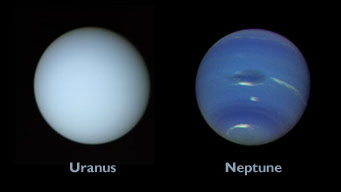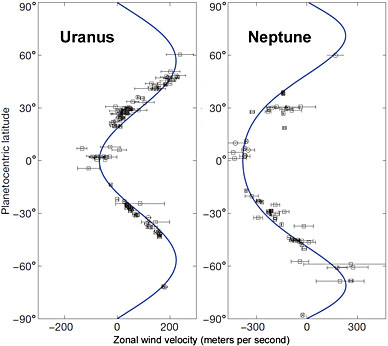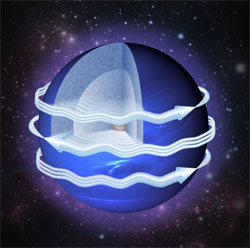Careful analysis of the gravity fields of our solar system's "ice giants", collected by Voyager 2 decades ago, suggests that weather patterns on these worlds are confined to a layer less than 600 miles (1,000 km) deep.
Two of the greatest achievements in planetary exploration occurred when Voyager 2 made flybys of Uranus (1986) and Neptune (1989). Officially the Voyager mission called for reconnaissance of Jupiter and Saturn only, but getting to the solar system's two ice worlds completed a "grand tour" of the giant planets that had been in the cards all along.

The outer solar system's "twin" planets looked very different when visited by Voyager 2 during the 1980s. Uranus, spinning on its side, had a nearly featureless disk. But Neptune displayed numerous bright and dark cloud patterns, including a hurricane-like featured dubbed the Great Dark Spot.
NASA / JPL
You would think that, by now, planetary scientists would have milked those data for every tidbit of scientific value. But research published this week offers surprising new insights using Voyager 2's quarter-century-old measurements.
In some ways, Uranus and Neptune are near twins. For example, their outer atmospheres are both very deep mixtures of hydrogen, helium, and methane, and their diameters are within 500 miles (800 km) of matching. The planet's winds create a pattern of east- and west-moving jets that mirror one another closely.
Yet the spin axis of Uranus is tipped over by 98°, which means its poles and midsection experience huge swings in sunshine throughout its 84-year orbit. And though Neptune is twice as far from the Sun, it displays much more vigorous cloud activity — one jet stream was clocked at 1,500 miles (2,500 km) per hour, the fastest winds in the solar system — and its interior emits 1.6 times more energy than it receives from the Sun.

The zonal jet streams on Uranus and Neptune share the same general pattern. But velocities on Neptune are higher — the prominent southern-hemisphere jet races around the planet at nearly 300 meters per second (1,500 miles per hour). Velocities are measured with respect to each planet's deep interior and with the polar values set to zero.
Yohai Kaspi & others / Nature
So does the energy to drive the storminess on these two planets come from their deep interiors, or is the weather layer skin deep, powered only by the weak light of a faraway Sun? Five researchers led by Yohai Kaspi (Weizmann Institute of Science, Israel) have taken a fresh look this question and conclude, in the May 16th issue of Nature, that the weather layers on Uranus and Neptune are at most 600 miles (1,000 km) deep.
They base this claim in part on the wind patterns seen by Voyager 2 and, in the decades since, by the Hubble Space Telescope. More critically, they used theories of global circulation developed by Kaspi and co-author Adam Showman (University of Arizona) to predict what the gravitational fields of Neptune and Uranus should look like. Then they compared those models to Voyager 2 gravity data. During each flyby, precise tracking revealed how the gravitational pull of Uranus and Neptune altered the spacecraft's trajectory. This in turn provided a rough estimate of the distribution of "rock," "ice" compounds like water and ammonia (virtually all in liquid form deep down), and gas inside each globe.

Jet streams encircling the giant planets Uranus and Neptune don't reach deep, according to a study published in May 2013.
Yohai Kaspi
The researchers included a fudge factor for the mass of each planet's upper atmosphere, which can vary because — just as on Earth — regions of high and low pressure, and thus density, are in constant motion. Kaspi and his colleagues got the best fit when they restricted the dynamic "weather" layer to just the outermost 0.15% of Uranus's total mass and 0.20% of Neptune's. "Our analyses show that the dynamics are confined to a thin weather layer no more than about 680 miles deep," says team member William Hubbard (University of Arizona).
The result is at odds with a longstanding notion, first proposed by theorist Fritz Busse in 1976, that the fluid interiors of these planets could be thought of as a set of nested cylinders rotating at different rates.
So why wasn't this paper written soon after the Voyager 2 encounters, I wondered. Hubbard took a stab at it in 1989, but the results were inconclusive. "Today of course we have much better methods than two decades ago," he comments in a University of Arizona press release, "so we can put a more accurate constraint on these phenomena than I was able to at the time.”
 2
2
Comments
Peter
May 19, 2013 at 1:35 pm
I would think by now planetary scientists would stop using “wind velocity” as a measure on the gas-giants. With no solid surface, the term is highly misleading. For example, the almost 300 m/s (about 600 mph) shown on the charts sounds like a monster hurricane, but in fact that velocity is with-respect-to the equator, thousands of kilometers away. The relevant measure is wind-shear, which is miniscule in this case, softer than a summer breeze. You could ride a hot-air balloon in these “300 m/s winds”! And while we are on the subject, gases--unlike liquids--decrease in viscosity with decreasing temperature. Therefore, as you go farther from the sun, “wind shear” can be expected to increase...which it does.
You must be logged in to post a comment.
Kelly Beatty
May 19, 2013 at 5:29 pm
Peter: you're on the right track, but actually those velocities are measured with respect to the spin rate of the planets' deep interiors, which are determined from timing their radio emissions and magnetic fields. I've modified the caption to make this clearer.
You must be logged in to post a comment.
You must be logged in to post a comment.